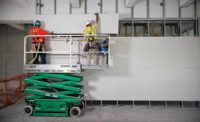Last month, I wrote about the USGBC’s ongoing efforts to transform the LEED rating system’s Materials and Resources credits from single-attribute-based criteria to a more comprehensive, balanced, and scientific method through newly emergent Environmental Product Declarations. There are other standards and certifications out there for many building materials and products—all of which have EPD-like qualities, but as I wrote last month, they are problematic due to a lack of transparency. It is transparency that people are after and what proponents of EPDs promise will be the core of every EPD produced.
Nutrition labels are to food as EPDs are to building materials or so the oft-repeated analogy goes. EPD proponents envision that eventually every building material will come with a label that indicates quantitative values for things like global warming, ozone depletion, acidification, eutrophication and more. The idea is a simple one: Give consumers quantitative, consistent, and comparative environmental information and they will be able to intelligently and confidently choose materials and products that best meet their sustainable goals.
WHAT IS AN EPD?
Done correctly, an EPD should provide “… all of the basic information and results necessary for a fully transparent declaration of environmental effects,” as explained on the ICC Evaluation Service website. ICC-ES is one of several Program Operators in the US authorized to development EPDs. To date it has developed and registered nine EPDs for acoustic ceiling panel products and has provided proposals to develop EPDs for six additional manufacturers for products they make. The development of an EPD requires that a manufacturer engage a Program Operator, develop something called a Product Category Rule, and conduct a Life Cycle Analysis in accordance with ISO Standard 14025 Environmental Labels and Declarations for Type III Environmental Declarations. This process ensures that the information presented is consistent and accurate enabling users to make direct product comparisons.
EPDs have been in development in many European countries for more than a decade. In the United States, the development of EPDs is in its infancy, the first of which were available only within the last couple of years. EPDs are available for fewer than 100 building materials including acoustic ceiling panels, carpeting, composite countertops, cedar siding and decking, and concrete ready mixes, made by just five manufacturers. There are a few more EPDs in process but manufacturers are not exactly rushing to develop EPDs for all their products according to ICC-ES Program Coordinator Steve Thorsell. Even in Europe, where EPDs have been legislated in some countries, participation is weak and EPDs hard to find. The reason? Cost and complexity, according to Thorsell.
COST VS. ROI
The meat of an EPD is its Life Cycle Analysis. Conducting an LCA is time consuming and difficult, and requires an experienced LCA specialist. The cost for conducting an LCA can be in the tens of thousands of dollars. ICC-ES does not provide LCA studies but can review them for a cost of $2,500 to $4,000. Thorsell states that the cost of developing a PCR can range anywhere from $25,000 to $30,000 and registering and posting each EPD ranges from $5,000 to $7,000. All added up, for a single EPD, a manufacturer will be required to spend up to $60,000. This is a difficult expenditure to justify for many manufacturers and many do not recognize any return on the investment.
Unless manufacturers are required to do so, Thorsell does not anticipate wide participation in developing EPDs. The possibility exists that building codes might require EPDs and this is something that has been proposed for the International Green Construction Code but was quickly shot down as something not ready for prime time. Thorsell doesn’t see a code requirement for EPDs any time soon, if ever, because the current process is “too squishy and too inconsistent.”
I HAVE EPDs, NOW WHAT?
A few years ago University of Washington Department of Architecture Assistant Professor Kate Simonen began developing a PCR for ready mix concrete. Simonen organized all necessary people and resources required for a PCR that culminated in EPDs for all mix designs of a ready mix producer in San Francisco, Central Concrete. Visit Central Concrete’s website and you will find the EPDs proudly and prominently displayed, along with a nice history of the entire process the company went through in becoming the first ready mix supplier to produce EPDs.
Examining the concrete mix EPDs is not unlike examining a food nutrition label—what you get out of it is entirely dependent on what you know beforehand. For example, I tend to focus on nutrition labels’ reporting of carbohydrate and protein, because I know and care about how they affect my body. I pay little to no attention to percentage of Vitamin A, riboflavin or red dye #2. Central Concrete’s EPDs contain a lot of information that is, quite honestly, Greek to me. Simonen agrees that much of the data provided is not very useful to a consumer, such as myself and suggests that it is appropriate to focus mainly on the Global Warming impact—the carbon footprint. She elaborates: “Of all the impact data presented in these EPDs, global warming is the only one that is affects the entire planet. All other impacts are regional and less important in determining concrete’s overall environmental impact.The amount of CO² released in the production and hydration of concrete closely correlates with the amount of cement. In focusing only on the carbon impacts of ready mix concrete, one would do well in getting to a more sustainable building.”
CONCLUSION
Are EDPs the wave of the future? Will they have a meaningful impact in making buildings greener? Opinions vary. Thorsell of ICC-ES feels that EPDs are not a good tool for making product comparisons. He thinks that there is too much guesswork involved in developing the LCAs, which are central to the quality of the EPD. One LCA can be quite different than another, and render any meaningful comparison moot. Simonen, on the other hand, is very optimistic about EPDs and their usefulness, but agrees that there are plenty of opportunities to get it wrong, especially for consumers, like architects and building owners.
The near absence of EPDs available to consumers is the biggest obstacle to a wide spread adoption of this new sustainable tool—I found EPDs for less than 100 products (more than half of those being carpet made by a single manufacturer) made by five manufacturers. The current requirement in LEED v4 is that a team must provide EPDs for 20 products made by at least five manufacturers—so if your project is in San Francisco, you may get the points. If not, tough luck.












